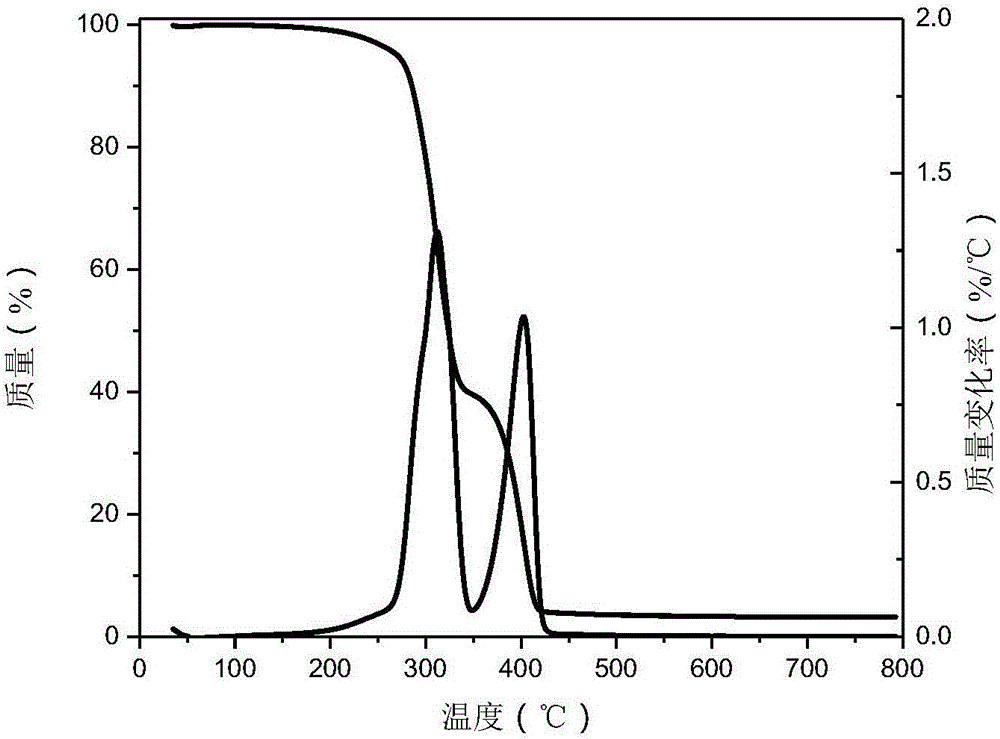Method using thermo-sensitive segmented copolymer to modify nano-diamond
A nano-diamond and block copolymer technology, applied in the fields of polymer materials and nano-materials, can solve problems such as no nano-microsphere products, and achieve the effects of improving dispersibility, reducing reaction time, and improving temperature sensitivity.
- Summary
- Abstract
- Description
- Claims
- Application Information
AI Technical Summary
Problems solved by technology
Method used
Image
Examples
Embodiment 1
[0033] The preparation of the first step temperature-sensitive block polymer: Add the polyethylene glycol (Mn=2000) of 6.1611g and the stannous octoate of 20mg in the there-necked flask that magnetic stir bar is housed, in N 2 Add 160mL of dry toluene, use a water separation reflux device, heat the oil bath at 130°C (the purpose is to azeotropically remove water from toluene), evaporate about 10mL of toluene, then add 10.6824g of ε-caprolactone with a syringe, and reflux the toluene for 120 ℃ reaction 12h. After the reaction was completed, cool to room temperature, then completely rotate the toluene to evaporate, add 20mL of dichloromethane to dissolve, 200mL of diethyl ether to precipitate, filter with suction, repeat the operation of dichloromethane dissolution-diethyl ether precipitation three times (to purify the product), and dry at 30°C in vacuum. Keep airtight. The obtained product is denoted as PCL-PEG-PCL. The number-average molecular weight of the temperature-sensi...
Embodiment 2
[0042] The first step and the second step are with embodiment 1.
[0043] The third step: take 0.2352g of acidified nano-diamond, 7mL of hexamethylene diisocyanate, 30mL of dry toluene, and ultrasonically disperse at room temperature for 2h, 2 Reaction at 60°C for 24h. After the reaction, wash and filter with dry toluene, repeat the operation 5 times, and dry in vacuum at 60° C. to obtain nanodiamonds with isocyanate functional groups on the surface.
[0044] Step 4: Take 0.0996g of the above-mentioned nano-diamond with isocyanate functional group, 3.0002g of temperature-sensitive block copolymer PCL-PEG-PCL, 50mL of toluene, ultrasonically disperse at room temperature for 2h, and place in N 2 Reaction at 110°C for 48h. After the reaction, wash and filter with dichloromethane, repeat the operation 5 times, and dry in vacuum at 60° C. to obtain nano-diamonds modified by temperature-sensitive block copolymers.
[0045] The average particle diameter of the modified nano-diamon...
Embodiment 3
[0047] The first step and the second step are with embodiment 1.
[0048] Step 3: Take 0.3859g of acidified nano-diamond, 10mL of hexamethylene diisocyanate, 50mL of dry toluene, ultrasonically disperse at room temperature for 2h, and 2 Reaction at 80°C for 12h. After the reaction, wash and filter with dry toluene, repeat the operation 5 times, and dry in vacuum at 60° C. to obtain nanodiamonds with isocyanate functional groups on the surface.
[0049] Step 4: Take 0.1206g of the above-mentioned nano-diamond with isocyanate functional group, 4.0164g of temperature-sensitive block copolymer PCL-PEG-PCL, 60mL of toluene, ultrasonically disperse at room temperature for 2h, and 2 Reaction at 110°C for 72h. After the reaction, wash and filter with dichloromethane, repeat the operation 5 times, and dry under vacuum at 60° C. to obtain nanodiamonds modified by temperature-sensitive block copolymers.
[0050] The average particle diameter of the modified nano-diamond is close to th...
PUM
| Property | Measurement | Unit |
|---|---|---|
| particle size | aaaaa | aaaaa |
| particle size | aaaaa | aaaaa |
| particle size | aaaaa | aaaaa |
Abstract
Description
Claims
Application Information
 Login to View More
Login to View More - R&D
- Intellectual Property
- Life Sciences
- Materials
- Tech Scout
- Unparalleled Data Quality
- Higher Quality Content
- 60% Fewer Hallucinations
Browse by: Latest US Patents, China's latest patents, Technical Efficacy Thesaurus, Application Domain, Technology Topic, Popular Technical Reports.
© 2025 PatSnap. All rights reserved.Legal|Privacy policy|Modern Slavery Act Transparency Statement|Sitemap|About US| Contact US: help@patsnap.com


